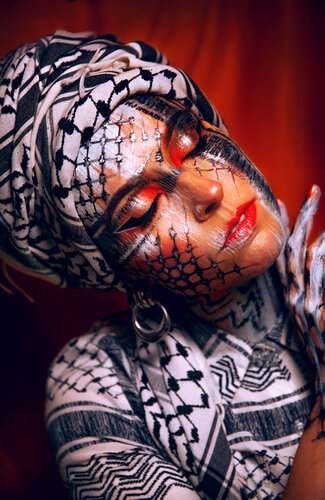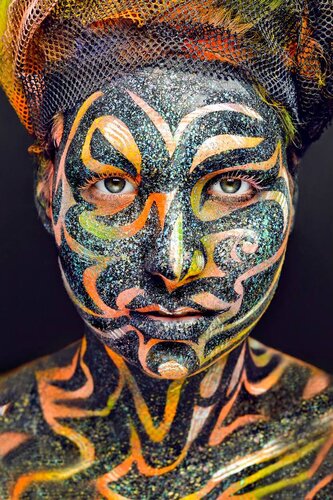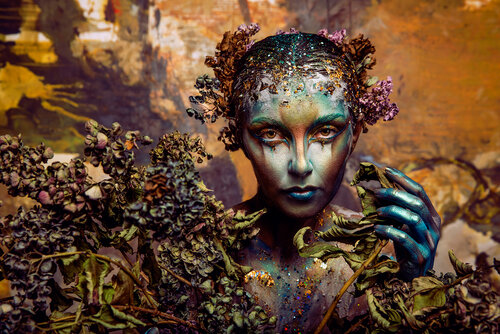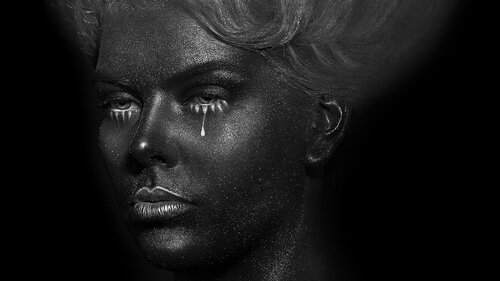Tell me this is not art (Self)
Tell me this is not art (Self)
A study of make-up & body-paint as an autonomous art form
Traditioneel was make-up gericht op een voornamelijk vrouwelijke markt en werd het vooral gebruikt om iemand te verfraaien. Hoewel het altijd een middel tot zelftransformatie was, gebeurde dat vroeger veel subtieler dan nu. De cosmetica-industrie heeft zich sterk ontwikkeld en het assortiment is enorm gegroeid. Tegenwoordig lijkt het aanbod aan make-upproducten wel op dat van een schilderwinkel, wat de creativiteit binnen de community enorm heeft bevorderd.
Tegelijkertijd groeide de online wereld, wat leidde tot een nieuwe kunstvorm met een grote online aanhang. Het gezicht wordt niet langer alleen als gezicht gezien, maar ook als canvas. Naast het ‘mooi’ maken, heeft make-up nu een tweede functie: het uitdragen van een eigen stem en het creëren van een gezicht als kunstwerk dat een alter-ego en eigen verhaal kan vertellen.
In 2009 bracht de Britse make-upartiest Alex Box een vernieuwende kijk op make-up. Zij was een van de pioniers die de manier waarop we naar beautyproducten en cosmetica kijken radicaal veranderde. Sindsdien zijn steeds meer artiesten haar voorbeeld gevolgd en begonnen te experimenteren. Haar boek werd op veel scholen aangehaald en opende mijn ogen voor wat make-up allemaal kan betekenen. Ondanks de enorme groei van de beautyindustrie is het aanbod van kunstboeken over deze kunstenaars helaas niet toegenomen. Hoewel er meer leerboeken over cosmetica beschikbaar zijn gekomen, bleef het aantal inspirerende boeken zoals dat van Alex Box hetzelfde.
Je zou je kunnen afvragen: Is het niveau binnen deze wereld dan wel hoog genoeg? Meer dan 15 jaar later is deze community online echter zo enorm gegroeid, dat niemand er online nog omheen kan.
Maar waarom zien we dit dan niet terug in onze scholen en bibliotheken? Als ik dat boek nooit had gezien, zou mijn werk er vandaag heel anders hebben uitgezien.
Online laten steeds meer artiesten hun stem horen als kunstenaar, maar in de echte wereld schort er nog iets.
Ik denk dat het probleem ligt in het feit dat de make-upwereld voornamelijk uit vrouwen bestaat. Uit veel onderzoeken blijkt dat deze groep nog steeds te weinig hun eigen stem laat horen. Het gevolg is dat deze voornamelijk vrouwelijke kunstvorm 15 jaar later nog steeds niet erkend is.
Kijk je naar de geschiedenis, dan zie je dat body-art en make-up altijd een belangrijke rol hebben gespeeld in het weergeven van historische, culturele en traditionele kenmerken van een land of tijdsgeest. Ondanks de constante aanwezigheid van make-up door de geschiedenis heen, wordt de make-upartiest vandaag de dag in de beeldende kunsten zelden erkend als kunstenaar en wordt hun creatie vaak alleen als functioneel gezien.
Wanneer mensen mij aanspreken en zeggen: ‘Jij bent een kunstenaar!’, voel ik mij door de Belgische wetgeving en kunstwereld niet aanvaard. Door een gebrek aan bewustwording rond de mogelijkheden van deze praktijk, krijgen make-upstudenten nog te vaak dezelfde boeken voorgeschoteld.
Het is opvallend dat andere kunstvormen zoals fotografie, schilderkunst en beeldhouwkunst, waar de mannelijke aanhang groter is, wel een autonome stem met bijbehorende rechten hebben gekregen.
Musea pleiten vaak voor meer vrouwelijke kunst en kunstenaars in hun zalen. Maar waarom blijven musea achter? Waarom zien we nog steeds voornamelijk schilderkunst, mode, fotografie, design en andere conceptuele kunst in hun zalen? Af en toe vind je een werk waar make-up wordt gevierd, maar bijna altijd wordt de maker van het portret, de fotograaf, in de schijnwerpers gezet.
Waarom kan de creatie in kwestie niet op zichzelf kan staan en een eigen verhaal vertellen?
Waarom kan de persoon die deze creaties ontwerpt en aanbrengt niet beschouwd als een beeldend kunstenaar?
Collega’s die vergelijkbare werken creëren en dit laten vastleggen door een fotograaf (ook al heeft de make-up en/of haar artiest het concept bedacht/gecreëerd) hebben tot op heden nog geen stem.
In magazines en kranten wordt zo goed als altijd de fotograaf als auteur van het werk gezien. Wat MUAH’s creëren, wordt nog steeds gezien in functie van mode, fotografie, film, tv, etc.
Make-up wordt volgens de kunstwereld alleen gezien in samenwerkingsverband.
Door dat achterhaalde idee zijn steeds meer make-up artiesten de afgelopen jaren zelf begonnen met documenteren, omdat zij de rechten als maker dan wel kunnen claimen.
En dat terwijl ik denk dat het ook anders kan.
Een set-fotograaf krijgt toch ook nooit automatisch de volledige rechten van de film wanneer hij of zij er een beeld van maakt? Waarom dan wel van wat een make-up artiest creëert?
----
Traditionally, make-up was targeted at a predominantly female market and was primarily used to enhance one's appearance. Although it has always been a means of self-transformation, it was done much more subtly in the past than it is now. The cosmetics industry has developed significantly, and the range of products has grown enormously. Today, the variety of make-up products resembles that of an art supply store, greatly fostering creativity within the community. At the same time, the online world has expanded, leading to a new art form with a large online following.
The face is no longer seen merely as a face, but also as a canvas. Besides enhancing beauty, make-up now has a second function: expressing one's own voice and creating a face as an artwork that can convey an alter ego and personal story.
In 2009, British make-up artist Alex Box introduced a revolutionary perspective on make-up. She was one of the pioneers who radically changed the way we view beauty products and cosmetics. Since then, more and more artists have followed her example and begun to experiment. Her book was referenced in many schools and opened my eyes to what make-up can truly mean. Despite the enormous growth of the beauty industry, the availability of art books about these artists has unfortunately not increased.
While more textbooks on the use of cosmetics have become available, the number of inspiring make-up art books like Alex Box's has remained the same. One might ask: Is the standard in this field high enough? More than 15 years later, this community has grown so large online that it is impossible to ignore.
But why don't we see this reflected in our schools and libraries? If I had never seen that book, my work would be very different today. Online, more and more artists are finding their voice as creators, but in the real world, something is still lacking. I believe the problem lies in the fact that the make-up world is predominantly female. Numerous studies show that this group still does not have enough representation. As a result, this primarily female art form is still not recognized 15 years later.
Looking at history, body art and make-up have always played an important role in representing the historical, cultural, and traditional characteristics of a country or era. Despite its constant presence throughout history, today the make-up artist is rarely recognized as an artist in the visual arts and their creation is often seen solely as functional.
When people approach me and say, 'You are an artist!', I do not feel accepted by Belgian legislation and the art world. Due to a lack of awareness about the potential of this practice, make-up students are still too often presented with the same books. It is striking that other art forms like photography, painting, and sculpture, where male participation is greater, have achieved an autonomous voice with corresponding rights.
Museums often advocate for more female art and artists in their galleries. But why are museums lagging behind? Why do we still see mainly painting, fashion, photography, design, and other conceptual art in their halls? Occasionally, you find a piece that celebrates make-up, but almost always the portrait maker, the photographer, is highlighted.
Why can't the creation itself stand alone and tell its own story? Why can't the person who designs and applies these creations be considered a visual artist?
Colleagues who create similar works and have them documented by a photographer (even if the make-up and/or hair artist conceived/created the concept) still do not have a voice.
In magazines and newspapers, the photographer is almost always credited as the author of the work. What MUAHs create is still seen as subordinate to fashion, photography, film, TV, etc. Make-up is only seen as part of a collaborative effort by the art world. Due to this outdated notion, more and more make-up artists have started documenting their work themselves in recent years, as this allows them to claim their rights as creators. I believe this shouldn't be necessary. A set photographer never automatically gets the full rights to the film when they take a picture of it, right? So why should they get the full rights to what a make-up artist creates?

Sarina Mannaert
Meer van deze kunstenaar
Ontdek open calls
Word uitgedaagd door heel diverse open calls of verspreid je eigen open call hier.
Vind kunstenaars
Zoek naar kunstenaars in je buurt of naar werk in een specifieke techniek.
Ontwerp: Studio Mast | Website: eps en kaas









